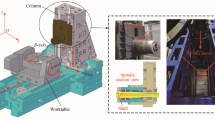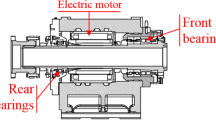Abstract
Thermal error is one of the main factors that leads to the decline of CNC machine tool’s accuracy stability. The location of the typical thermal key points was determined by the finite element analysis model of the spindle system. The thermal experiments were conducted on a spindle of the milling machine tool. Furthermore, the distribution law of the spindle temperature field and the mechanism of its deformation were elaborated. On this basis, the temperature field model of each region of a spindle system was established based on the generation, conduction, and convection theory of heat, spindle speed, and motor load. A physical driven deformation modeling (PDDM) method was put forward for building the relationship between the axial thermal drift error and the temperatures of the key points of the spindle system. Then, with parameters identified using data of one speed, the influence of structural size uncertainty on prediction results was analyzed by the first-order second-moment (FOSM) method. The prediction residual errors of the suggested model with multiple size parameter fluctuation were provided. Finally, the effectiveness and robustness of the time-varying error model were verified by experiment and compensation.
















Similar content being viewed by others
Abbreviations
- A s :
-
Heat generation coefficient caused by spindle rotating
- B s :
-
Convective heat transfer coefficient caused by spindle rotating
- C s :
-
Heat dissipation coefficient
- A m :
-
Heat generation coefficient caused by rotor operation
- ω:
-
Spindle rotating speed
- k I _i :
-
Heat conductivity coefficient (i.e., I–i:1–2,1–3)
- L 1 :
-
Length of the spindle
- L 2 :
-
Length of the spindle box
- L 3 :
-
Width of the column
- L 4 :
-
Length of the column
- E tcz :
-
Tested axial thermal error
- E ccz :
-
Calculated axial thermal error
- T tI :
-
Tested temperature of section I
- T cI :
-
Calculated temperature of section I
- P :
-
Number of the motor load at time t
- N :
-
Total test time
References
Zhang Lx, Li Cq, Li Jp, Zhang K, Wu Yh (2017) Temperature rise prediction model of high-speed and high-precision motorized spindle. Int J Mech Eng 53(23):129–136. https://doi.org/10.1016/j.csite.2021.101056
Ibaraki S, Inui H, Hong C, Nishikawa S, Shimoike M (2019) On-machine identification of rotary axis location errors under thermal influence by spindle rotation. Int J Precis Eng 55:42–47. https://doi.org/10.1016/j.precisioneng.2018.08.005
Li Y, Wei WM, Su DX, Zhao WH, Zhang J, Wu WW (2018) Thermal error modeling of spindle based on the principal component analysis considering temperature-changing process. Int J Adv Manuf Techol 99(5–8):1341–1349. https://doi.org/10.1007/s00170-018-2482-z
Li D, Feng P, Zhang J, Wu ZJ, Yu DW (2015) Method for modifying convective heat transfer coefficients used in the thermal simulation of a feed drive system based on the response surface methodology. Int J Numer Heat Tran Part A: Applications 69(1):51–66. https://doi.org/10.1080/10407782.2015.1037130
Liu K, Han W, Wang YQ (2021) Review on thermal error compensation for axes of CNC machine tools. Int J Mech Eng 57:156–173
Shi H, Qu QQ, Mei XS, Tao T, Wang HT (2023) Robust modeling for thermal error of spindle of slant bed lathe based on error decomposition. Int J Case Stud Therm Eng 51:103564. https://doi.org/10.1016/j.csite.2023.103564
Liu K, Liu Y, Sun MJ, Wu YL, Zhu TJ (2017) Comprehensive thermal growth compensation method of spindle and servo axis error on a vertical drilling center. Int J Adv Manuf Technol 88:2507–2516. https://doi.org/10.1007/s00170-016-8972-y
Li Y, Zhao W, Lan S, Ni J, Wu W, Lu B (2015) A review on spindle thermal error compensation in machine tools. Int J Mach Tool Manufact 95:20–38. https://doi.org/10.1016/j.ijmachtools.2015.04.008
Liu J, Ma C, Gui H, Wang S (2021) Thermally-induced error compensation of spindle system based on long short term memory neural networks. Int J Appl Soft Comput 102:107094. https://doi.org/10.1016/j.asoc.2021.107094
Liu H, Miao E, Zhuang X, Wei X (2018) Thermal error robust modeling method for CNC machine tools based on a split unbiased estimation algorithm. Int J Precis Eng 51:169–75. https://doi.org/10.1016/j.precisioneng.2017.08.007
Tan F, Yin M, Wang L, Yin G (2018) Spindle thermal error robust modeling using LASSO and LS-SVM. Int J Adv Manuf Technol 94(5–8):2861–2874. https://doi.org/10.1007/s00170-017-1096-1
Zhang K, Yao X, Zhang Y, Yang J (2011) Thermal error modeling based on optimum selection of time series models. Modul Mach Tool Autom Manuf Techn 10:36–39
Liu K, Sun MJ, Zhu TJ, Wu YL, Liu Y (2016) Modeling and compensation for spindle’s radial thermal drift error on a vertical machining center. Int J Mach Tools Manuf 105:58–67. https://doi.org/10.1016/j.ijmachtools.2016.03.006
Peng J, Yin M, Cao L, Liao QH, Wang L, Yin GF (2022) Study on the spindle axial thermal error of a five-axis machining center considering the thermal bending effect. Int J Precis Eng 75:210–226. https://doi.org/10.1016/j.precisioneng.2022.02.009
Shi XJ, Yang X, Xiao MuYJ, Wang YZ, Wang WK (2019) Thermal error compensation model for a motorized spindle with shaft core cooling based on exponential function. Int J Adv Manuf Technol 103(9–12):4805–4813. https://doi.org/10.1007/s00170-019-04038-w
Liu K, Chen F, Zhu TJ, Wu YJ, Sun MJ (2016) Compensation for spindle’s axial thermal growth based on temperature variation on vertical machine tools. Int J Adv Mech Eng 8(8):2071834861. https://doi.org/10.1177/1687814016657733
Liu K, Li T, Hb Liu, Liu Y, Wang YQ (2020) Analysis and prediction for spindle thermal bending deformations of a vertical milling machine. Int J IEEE Trans Ind Inf 16(3):1549–1558. https://doi.org/10.1109/TII.2019.2926991
Kang CM, Zhao CY, Liu K, Li TJ, Yang B (2018) Comprehensive compensation method for thermally induced error of a vertical drilling center. Int J Can Soc Mech Eng 43(1):92–101. https://doi.org/10.1139/tcsme-2018-0079
Liu K, Song L, Liu H, Han W, Sun MJ, Yq Wang (2021) The influence of thermophysical parameters on the prediction accuracy of the spindle thermal error model. Int J Adv Manuf Technol. 115(1–2):617–626. https://doi.org/10.1007/s00170-021-07256-3
Song L, Liu K, Zhao D, Zhang ZW, Yq Wang (2023) The spindle axial time-varying thermal error compensation method for horizontal boring and milling machine tool based on edge computing. Int J Adv Manuf Technol 128(5–6):2631–2638. https://doi.org/10.1007/s00170-023-11927-8
Ma C, Zhao L, Mei X, Shi H, Yang J (2017) Thermal error compensation of high-speed spindle system based on a modified BP neural network. Int J Adv Manuf Technol 89(9–12):3071–3085. https://doi.org/10.1007/s00170-016-9254-4
Kang CM, Zhao CY, Zhang JQ (2020) Thermal behavior analysis and experimental study on the vertical machining center spindle. Int J T Can Soc Mech Eng 44(3):344–351. https://doi.org/10.1139/tcsme-2019-0124
Liu Y, Meng LL, Liu K, Zhang Y (2016) Chatter reliability of milling system based on first-order second-moment method. Int J Adv Manuf Technol 87(1–4):801–809. https://doi.org/10.1007/s00170-016-8523-6
Dai Y, Pang J, Rui KK, Li WW, Wang QH, Li SK (2023) Thermal error prediction model of high-speed motorized spindle based on DELM network optimized by weighted mean of vectors algorithm. Int J Case Stud Therm Eng 47:103054. https://doi.org/10.1016/j.csite.2023.103054
Acknowledgements
The authors thank the anonymous referees and editor for their valuable comments and suggestions.
Author information
Authors and Affiliations
Contributions
CMK: writing software and original draft preparation. YXG: conceptualization, methodology, and validation.
Corresponding author
Ethics declarations
Competing interests
The authors declare no competing interests.
Additional information
Publisher's Note
Springer Nature remains neutral with regard to jurisdictional claims in published maps and institutional affiliations.
I would like to declare on behalf of my co-authors that the work described was original research that has not been published previously and not under consideration for publication elsewhere, in whole or in part. All the authors listed have approved the manuscript that is enclosed.
Rights and permissions
Springer Nature or its licensor (e.g. a society or other partner) holds exclusive rights to this article under a publishing agreement with the author(s) or other rightsholder(s); author self-archiving of the accepted manuscript version of this article is solely governed by the terms of such publishing agreement and applicable law.
About this article
Cite this article
Kang, C., Guo, Y. The thermal drift modeling of spindle system based on a physical driven deformation methodology. Int J Adv Manuf Technol 130, 1207–1219 (2024). https://doi.org/10.1007/s00170-023-12720-3
Received:
Accepted:
Published:
Issue Date:
DOI: https://doi.org/10.1007/s00170-023-12720-3




